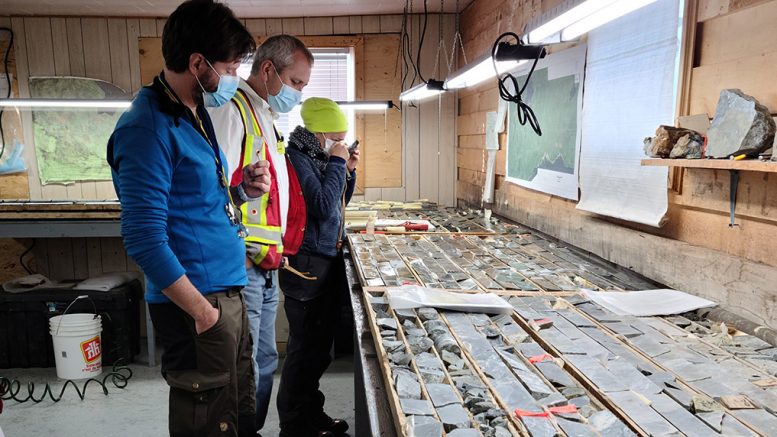Canadian mineral exploration and development company Buchans Resources has entered into a collaboration agreement with Boliden Mineral AB, a European-based mining and metals producer.
Under the agreement, Boliden will evaluate Buchans’ wholly-owned Buchans volcanogenic massive sulphide (VMS) base metals property in central Newfoundland, 56 km southeast of Deer Lake.
The agreement is “a little like an engagement to see if the parties are compatible before they get married,” says John Kearney, Buchans’ chairman and CEO.
“Boliden has extensive experience of developing VMS deposits with very similar geology to that found in Newfoundland, and so are uniquely qualified to help us advance the Buchans VMS project,” he said in an interview.
The relationship between the two companies was developed several years ago through Buchans’ Irish subsidiary Minco Exploration. Minco has licensing agreements with Boliden on several properties, including a property immediately adjacent to Boliden’s Tara mine near Navan in Ireland, the largest zinc mine in Europe, which generates 2.6 million tonnes of ore annually for the production of zinc and lead concentrates.
Buchans has agreed to grant Boliden exclusivity to the Buchans VMS property for one year ending Dec. 31, 2021 — enough time for Boliden to evaluate the project and decide whether it wants to negotiate an earn-in option agreement.
During this period, Buchans will not provide information to or negotiate with any third party on the project and, assuming Boliden submits a proposal, will provide Boliden with the right of first refusal for a further six-month period should another offer be made on the property.

Facilities and equipment from historic operations at the Buchans mine in Newfoundland. Credit: The Northern Miner.
Boliden will share technical data from its geological/geophysical review and will pay Buchans $600,000 for maintaining the property and undertaking exploration and evaluation programs during the exclusivity period.
Kearney said the contribution would be used to fund work programs, including the compilation of data, preparation of a new three-dimensional geological model, and geophysical surveys.
Buchans is planning to spend around $1-2 million on the programs over the next twelve months, and although it has some money in its treasury, it will likely need to raise additional capital to fund the work, he said.
As far as jurisdictions are concerned, Kearney noted that the nearby town of Buchans was built by a mining company and is very supportive of mining, as is the government of Newfoundland and Labrador, both of which, he said, want to see investment in the area.
“The project is extremely well located with existing infrastructure, including paved highways that provide direct access to the property, and a locally-based workforce,” he said.
The first reported exploration of the Buchans area dates to 1905 when high-grade lead-zinc mineralisation was discovered in the banks of the Buchans River, east of the current main Buchans mine at Lucky Strike, a former near-surface underground mine operated by the American Smelting and Refining Company (Asarco) from 1928 until its closure in 1984.
Over this period, Asarco is reported to have produced 16.2 million tonnes of mineralized material from five major orebodies, with average grades of 14.51% zinc, 7.65% lead, 1.33% copper, 126 grams silver per tonne, and 1.37 grams gold per tonne.
Between 1985 and 2007, various operators managed the property, mainly BP Resources Canada Inc. and the Buchans River Joint Venture companies, and exploration was primarily focused on regional geophysical and geochemical programs and minor follow-up drill programs.
In 2007, Buchans Resources took over as the operator.
A review of historical data in September of that year identified a zone of stockwork mineralisation underneath the Lucky Strike mine, which they called the Lundberg zone. Immediately south of Lucky Strike, a second zone of stockwork mineralisation was also identified and named the Engine House zone.
A preliminary economic assessment for the combined zones in 2011 envisioned an open-pit mine producing 5,000 tonnes per day over a mine life of 10 years. The PEA was based on a resource estimate of 17.28 million inferred tonnes grading 1.63% zinc, 0.69% lead, 0.4% copper, 1.24% barium, 5.96 grams silver, and 0.07 gram gold.
In 2014, Buchans conducted further exploration to assess Lundberg and the immediate surrounding area. The work focused on the re-logging of historical core from the Lucky Strike and Engine House orebodies, including 9,200 metres of core from 87 drill holes.
As a follow up to the re-logging program, the company also completed a five-hole 642.6-metre diamond drill program to explore for shallow extensions to the high-grade Lucky Strike deposit and the lower grade Lundberg and Engine House zones.
The company continued to re-log core through 2015, re-logging 650 drill holes totalling 123,000 metres, including 420 holes within Lundberg.
In 2018, Buchans completed a 28-hole, 5,111-metre drill program, including 17 infill and step-out holes drilled at Lundberg and 11 holes drilled to explore for higher-grade VMS deposits within a 3.5 km radius of Lundberg.
An updated mineral resource estimate for Lundberg in 2019 outlined indicated resources of 16.79 million tonnes grading 1.53% zinc, 0.64% lead, 0.42% copper, 5.69 grams silver, and 0.07 gram gold (3.38% zinc equivalent) for 1.25 billion lb. zinc equivalent. Inferred resources added 380,000 tonnes grading 2.03% zinc, 1.01% lead, 0.36% copper, 22.35 grams silver, and 0.31 gram gold (4.46% zinc equivalent) for 37 million lb. of zinc equivalent.
To date, Buchans has re-logged more than 154,000 metres of archived drill core from approximately 850 drill holes, including several target areas adjacent to several of the project’s historic, undeveloped deposits and prospects.
“We’ve probably done more than enough re-logging for now, so the next task is to pull all that information together and build a bigger 3D model to understand better where these mineralised zones are located,” Kearney said.
The company plans to use modern geological interpretation methods and Boliden’s experience with VMS deposits to try and identify new high-grade orebodies that Asarco didn’t find and revitalise this world-renowned historic VMS mining camp.


Be the first to comment on "Buchans signs agreement with Boliden to advance Buchans VMS project"